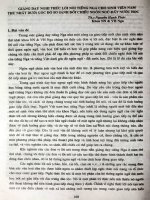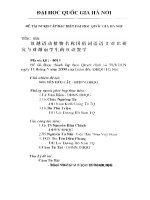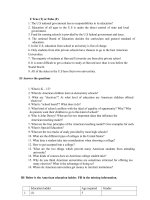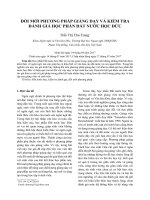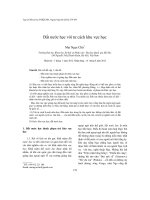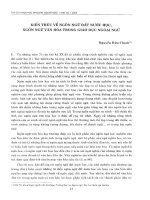dat nuoc hoc American Economy
Bạn đang xem bản rút gọn của tài liệu. Xem và tải ngay bản đầy đủ của tài liệu tại đây (1.42 MB, 42 trang )
<span class='text_page_counter'>(1)</span>HELLO, EVERYBODY…. HI, … HI, … HI, … HI, ….
<span class='text_page_counter'>(2)</span> Economy of the United States. GDP : GDP $14.441 trillion (2008) GDP growth0.4% (2008) GDP per capita$47,422 (2008) (10th) . . . Currency: United States Dollar (USD) Trade organizations: NAFTA, WTO, OECD, G-20 and others. GDP by sector agriculture (0.9%), industry (20.6%), services (78.5%).
<span class='text_page_counter'>(3)</span> . . . Main industries : petroleum, steel, motor vehicles, aerospace, telecommunications, chemicals, creative industries, electronics, food processing, lumber, mining, defense Main export partners : Canada, 21.4%; Mexico, 11.7%; China, 5.6%; Japan, 5.4%; Germany 4.3%; United Kingdom, 4.1% Main import partners : China, 16.9%; Canada, 15.7%; Mexico, 10.6%; Japan, 7.4%; Germany, 7.4%..
<span class='text_page_counter'>(4)</span> 09. THE AMERICAN ECONOMY CONTENT Basic ingredient of the U.S economy. The free enterprise system. Changes over times. The stock market. The situation today.
<span class='text_page_counter'>(5)</span> Additional shipping access. Labor-force quality. productivity. Fertile farm soil. AMERICAN ECONOMY. Moderate climate. Mobility. Extensive coastline. Available workers. Mineral resources.
<span class='text_page_counter'>(6)</span> - mineral resources - mobility - productivity - fertile farm soil - moderate climate - Labor force quality - Extensive coastline - Available workers - additional shipping access. Put the phrases above into the suitable columns Natural resources. labor. ............................... ............................... ............................... ............................... ................................ ............................... ............................... ............................... ............................... ................................
<span class='text_page_counter'>(7)</span> Natural resources - mineral resources - fertile farm soil - moderate climate - extensive coastline - additional shipping access. labor mobility - productivity - labor force quality - available workers -.
<span class='text_page_counter'>(8)</span> Natural Resources. - Rich in mineral resources and fertile farm soil - A moderate climate - Extensive coastline on both the Atlantic and Pacific, as well as on the Gulf of Mexico. - Rivers flow from far within the continent and the Great Lake provide additional shipping access. These extensive waterways have helped shape the country’s economic growth.
<span class='text_page_counter'>(9)</span> Facts about American Labor force : 155 million (includes labor. -. unemployed) (2008) Labor force by occupation: managerial and professional (35.5%), technical, sales and administrative support (24.8%), services (16.5%), manufacturing, mining, transportation, and crafts (24%),.
<span class='text_page_counter'>(10)</span> labor Convert natural resources into goods - Available worker and productivity: help determine the health of an economy - labor mobility - labor-force quality American labor market has attracted immigrants from all over the world and has one of the world’ s higest migration rates. .
<span class='text_page_counter'>(11)</span>
<span class='text_page_counter'>(12)</span>
<span class='text_page_counter'>(13)</span> 1.the quality of available worker . . how hard people are willing to work and how skilled they are -hard working is known as the Protestant work ethic -a strong emphasis on education, including technical and vocational training Contribute to America's economic success.
<span class='text_page_counter'>(14)</span>
<span class='text_page_counter'>(15)</span> 2.labor mobility . . It has been important to the capacity of the American economy to adapt to changing conditions Ex: when immigrants flooded labor markets on the east coast, many workers moved inland, often to farmland waiting to be tilled.
<span class='text_page_counter'>(16)</span>
<span class='text_page_counter'>(17)</span>
<span class='text_page_counter'>(18)</span> 3.labor force quality . Government leaders and business officials increasingly stress the importance of education and training to develop workers with the kind of nimble minds and adaptable skills.
<span class='text_page_counter'>(19)</span> . . But natural resources and labor account for only part of an economic system. These resources must be organized and directed as efficiently as possible.
<span class='text_page_counter'>(20)</span> . . Chief excutive : tổng thống Boardroom :phòng họp ban điều hành Foreman: viên quản đốc Systematic analysis: sự phân tích có hệ thống Hierarchy (n) tính thứ bậc Inhibit (v) kiềm hãm Interdisciplinary (a) thuộc nhiều lãnh vực.
<span class='text_page_counter'>(21)</span> Traditional managerial structure (based on a top-down chain of command) Chief excutive (in the boardroom) make sure that the entire business. runs smoothly and efficiently. various lower levels of management coordinating different. parts of the enterprise. Foreman (on the shop floor). This specialization or division of labor is called “ scientific management”.
<span class='text_page_counter'>(22)</span> Why American businesses seek more flexible organization structures, especially in high-technology industries? Disadvantages of traditional structure: excessive hierarchy and division of labor have inhibited the creativity Facing heightened global competition So they are seeking another structure that employ skilled workers and must develop, modify, and even customize products rapidly by reducing the number of managers and delegating more authority to interdisciplinary teams of workers.
<span class='text_page_counter'>(23)</span> What makes American economy develop rapidly?.
<span class='text_page_counter'>(24)</span> Answer . . . 1. Vast natural resources, vast areas of highly productive farmlands 2. Vast labor resources 3. A large unified markets 4. A supportive political legal system 5. An entrepreneurial spirit 6. Commitment to investing in material and human capital 7. Able to exploit resources due to a unique set of institutions designed to encourage exloration and extraction..
<span class='text_page_counter'>(25)</span> What are corporations? corporations. a voluntary association of owners. an effective device for accumula ting the funds. have financial resources.
<span class='text_page_counter'>(26)</span> Where are corporations able to have necessary capital? . . - by selling stock or bonds to insurance companies, banks, pension funds, individuals, and other investors. - some institutions, especially banks also lend money directly to corporations or other business enterprises..
<span class='text_page_counter'>(27)</span> . Federal and state government have developed detailed rules and regulations to ensure the safety and soundness of this financial system and to foster the free flow of information so investors can make wellinformed decisions..
<span class='text_page_counter'>(28)</span> . . The U.S economy is based on the free enterprise system Since the depression of the 1930s, when the economy essentially collapsed, laws have been made giving the government a more active role..
<span class='text_page_counter'>(29)</span> the second half of the last century the U.S was a mainly agricultural nation 1950s and 1960s grew rapidly. 1995 agricultural exports exceeded imports by nearly two to one By the end of WW II had the greatest productive capacity of any country in the world. civil war helped stimulate industry, industrialization transformed the country. mid 1970s economic growth began to slow down. •There had been a shift from agriculture to industry and now from industry to services.
<span class='text_page_counter'>(30)</span> . Matching the time from column A to the suitable sentences in column B. 1. the second half of the last century a. the U.S was a mainly agricultural nation 2. 1995. b. agricultural exports exceeded imports. 3. Civil war. by nearly two to one c. had the greatest productive capacity of any country in the world d. grew rapid e. helped stimulate industry, industrialization transformed the country economic growth f. began to slow down. 4. 1950s and 1960s 5. By the end of WW II 6. Mid 1970s. ANSWER: 1-A ; 2-B ; 3-E ; 4-D ; 5-C ; 6-F.
<span class='text_page_counter'>(31)</span> What is the stock market? It is a public market for trading of company stock and derivatives at an agreed price Stock market = stock exchange.
<span class='text_page_counter'>(32)</span> company Raise the money. issue. share sell. Stock market. you. A part owner Of company right to vote on members of board of directors. Receive profits.
<span class='text_page_counter'>(33)</span> . Entrepreneur (n) nhà thầu khoán Bond (n) công trái Transaction (n) sự giao dịch Periodic (a) tính chu kì Dividend (n) tiền lời.
<span class='text_page_counter'>(34)</span> . . . The stock markets are very busy everyday except for weekends and holidays. In general, prices for shares of stock are rather low but Americans of modest means still buy and sell shares. There is no guarantee that the business behind the stock will perform well. But they still buy and sell shares.
<span class='text_page_counter'>(35)</span> There are some reasons . . 1.in hopes of making profits in the form of periodic stock dividends. 2.they also hope that the price of the stock will go up over time, so that in selling their shares will make an additional profit..
<span class='text_page_counter'>(36)</span> . The New York Stock Excha nge is a stock exchange located at 11 Wall Street in lower Manhattan, New York City, New York, USA. It is the largest stock exchange in the world by United States dollar value of its listed companies' securities.
<span class='text_page_counter'>(37)</span> . 1. Why Americans take part in stock market? 2. When did Vietnamese stock market begin to work?.
<span class='text_page_counter'>(38)</span>
<span class='text_page_counter'>(39)</span>
<span class='text_page_counter'>(40)</span> A large country. A leading producer of fuel. International trade is important. Increasing productivities or the efficiency of the labor force. AMERICA N Faces some major economic challenges. A leading producer of many minerals. A major consumer of resources. Traing people to fill new kinds of jobs.
<span class='text_page_counter'>(41)</span> Can you tell me about some major economic challenges of the U.S?.
<span class='text_page_counter'>(42)</span>
<span class='text_page_counter'>(43)</span>

